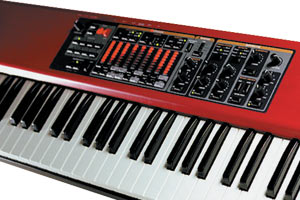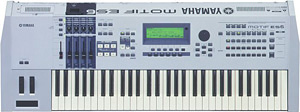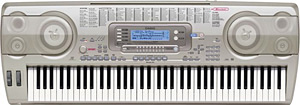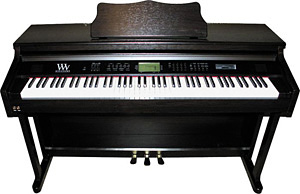"Keyboard Buying Guide"

The keyboard category at Musician's Friend includes a broad range of products, from simple MIDI controllers and basic digital pianos to multi-thousand dollar workstations. Before diving in, it's important to know exactly what you're looking for. This guide will help you figure out what kind of keyboard and features to look for to best suit your needs.
Types of Keyboards
Understanding what each type of keyboard is intended for and capable of can be confusing. Given the number of products in each of the four keyboard categories at Musician's Friend, it's imperative that you know exactly what you're shopping for before you start. We'll be looking at synthesizers, workstations, arrangers, portables, digital pianos, organs, and MIDI controllers.
Common features
There are many attributes that span all or most categories of keyboards. These are basics that you should familiarize yourself with before getting into the specific features of each keyboard category.
Number of keys » Keyboards are available with various numbers of keys, ranging from 25 on small MIDI controllers up to 88, just like on a traditional acoustic piano. Things to consider when deciding how many keys are right for you are space restrictions and the types of passages you'll be playing.
Action » You will come across various terms relating to the response of the keybed. Weighted, semi-weighted, Synth, and hammer action each offer a different feel. Weighted and semi-weighted actions have a response similar to a traditional piano. Hammer action adds actual mechanical hammers to enhance this response even more. Synth action is more like an organ; there is no resistance and the keys can be played very quickly. If you're accustomed to the feel of a piano, you'll want a keybed that's weighted or semi-weighted, and perhaps with hammer action if you really want a true piano feel. If you're the type of player who plays a lot of fast lead passages, a Synth-action keybed will probably suit your needs better.
Touch or velocity sensitivity » The ability of a keyboard to sense the force or speed with which a key is pressed and create a sound or send a MIDI message accordingly.
Polyphony » The number of sounds a keyboard can generate at one time.
Multitimbrality » The ability of a keyboard to play different sounds at once (i.e., flute, drums, strings, piano) Multitimbrality should not be confused with polyphony.
MIDI compatibility » MIDI (Musical Instrument Digital Interface) is a communication protocol established in the 1980s for electronic instruments and computers. MIDI messages contain no musical information, but rather serve as a blueprint that tells a hardware or software instrument what notes to play and with what velocity. For example, a MIDI passage could be sent to a keyboard that in turn could play the same passage with any of the sounds available in the instrument. MIDI compatibility enables a keyboard to send and receive MIDI messages.
Computer connectivity » Today's keyboards can connect to a computer in a variety of ways. USB, FireWire, MIDI, S/PDIF, mLAN, and other types of interfaces, either external or built into a keyboard, are ways for computers and keyboards to communicate.
Sequencer » A hardware or software device that records MIDI performance data and plays it back in a user-programmed sequence.
Arpeggiator » An arpeggio is a chord whose notes are played in succession rather than all at once. An arpeggiator electronically creates an arpeggio when a single note is played on the keyboard.
Sampler » A device that records digital audio and allows it to be altered and played back in various ways. If you plan to incorporate external audio clips into your music, you'll definitely want a keyboard with a built-in sampling.
Input/output » The input and output section of a keyboard is something you'll want to consider before buying. If you plan to use your keyboard as a digital audio workstation, having audio ins/outs can save you from having to purchase a separate interface. Audio outputs that connect to external amplifiers, mixers, and speakers are a must if you plan to play live with your keyboard.
Controllers » The amount of control a keyboard offers depends greatly on what you'll be doing with it. For synths, you'll at least want pitch and modulation wheels. As you get into working with MIDI, you may want to have knobs and sliders as well, especially if you're shopping for a MIDI controller. Many keyboards offer visual displays--some with touch capability--to give you more control and ease of use.
Storage » Many keyboards offer internal storage options such as floppy disk drives, SmartMedia card slots, CD burners, or hard drives. Others offer external solutions such as USB connectivity so you can transfer data between a computer and your keyboard.
Expansion » A keyboard with ROM (Read-Only Memory) expansion slots allows additional sound cards can to added that offer additional sound sets. This is a valuable feature if you plan on having your keyboard for a long time. RAM (Random Access Memory) expansion slots allow you to add more memory for samples on a keyboard with sampling functionality.
Synthesizers
Synthesizers are keyboards that for the most part just produce sounds. Most synthesizers today use sample-based synthesis--that is, they use prerecorded sounds as opposed to analog synths that manipulate electrical signals to create their sounds. Analog synths still exist, though they are few and far between. The technology of analog synthesizers has improved greatly over the years, and they have distinct sounds that many players demand, although many digital synths emulate them with great accuracy. Sample-based synths generally provide a much larger sound set, including piano, organ, horns, strings, and even digital re-creations of classic analog synths. Some synths offer basic sequencing functions as well.
The first thing you should do before shopping for a synthesizer is define your needs. What style of music do you play? How many keys will be sufficient for you? What sounds are most important to your style? A keyboard player in a metal band will obviously have different answers than someone in a country/western band. Musician's Friend offers sound clips for many of the synthesizers we sell to help you get an idea of their soundsets. It's also important to decide what your budget will be for your Synth. Thanks to technological advances, even less-expensive synths come with quality soundsets and keyboard action. So there are plenty of synths to choose from if you don't have tons of money to spend.
Synthesizers include a number of sounds built into the ROM. If you are the kind of player who just wants to plug in and start playing, then you'll want a Synth with a lot of presets. If you'd rather create your own unique sounds, be sure to select a Synth with plenty of user patch locations (memory slots that allow you to save your sonic creations). Being able to expand the ROM is valuable as well, as it will allow you to update your Synth with new or different sound sets.

The Alesis QS8.2 is an 88-key Synth with 16MB of WAV ROM, weighted keys, 64-voice polyphony, and 24-bit D/A conversion, an expansion slot, and much
more. There are numerous controls that let you shape a
synthesizer's sounds.
Envelope
controls let you tailor the attack, sustain, decay, and release time of a sound. A
low-frequency oscillator,
or LFO, allows you to alter various parameters of a
tone.
For example, applying the LFO to a tone's pitch creates a vibrato effect. A synthesizer's
filter
section can be used to remove certain frequencies from a sound and change its timbre. Many synthesizers also have built-in
effects
like reverb, delay, chorus, and more. If you enjoy pushing the sonic boundaries with what you play, then these are features you'll want to look for in your purchase.
Workstations
A workstation can be thought of as a miniature composing, recording, and production studio. Most workstations have a number of recording features, such as the ability to record audio, an internal hard drive, multitrack recording, built-in CD burners, etc. Workstations are the pinnacle of the professional keyboard world, and will provide the experienced songwriter or producer with the tools needed to craft, record, edit, and finalize songs.
In choosing a workstation, it's important to be sure it provides enough polyphony to handle the passages you'll play and record. When doing multitrack sequencing, the notes on any track are subtracted from the workstation's total polyphony. The more notes the unit can handle, the more you'll be able to make good use of its recording and sequencing capabilities.
The sound sets in most workstations rival those of the top synthesizers. Manufacturers understand that the device will be used for composing and recording, so they tend to load them up with massive sound libraries. You'll typically find a huge array of instruments, such as pianos, guitars, horns, strings, drums, and more. This, of course, lends itself to the workstation being a complete studio-in-a-box.
Computer connectivity is an important function to have in a workstation too, as it allows you to easily sync your workstation with computer recording software. Most workstations come with MIDI and/or USB connections, and some incorporate an mLAN interface that handles MIDI and audio data transfers to and from other devices in your recording network via a FireWire cable. Workstations usually provide audio inputs as well so you can record instruments directly.
Trigger pads are a valuable feature if you want quick access to notes or samples. Hip-hop and R&B producers tend to like them for laying down quick beats and loops, though they can be used in a variety of situations.

The Yamaha MOTIF ES6 is a highly advanced workstation with 128-voice polyphony, 175MB WAV ROM, and powerful production features like advanced sequencing, effects, mastering tools, and much more.
Some workstations also incorporate a sampler. Having a sampler means you can import any digitized sound you can think of and put it to use in your music--a worthwhile feature if you like to experiment with sounds outside the realm of standard instruments.
Workstations are powerful instruments designed primarily for players who are experienced with sequencing and recording. Chances are if you are shopping for your first keyboard, a workstation might be a little over your head. That's where our next category comes in.
Arrangers
If a workstation can be viewed as a studio, an arranger can be compared to a songwriting partner. Arrangers are portable-style keyboards with professional sound engines and a number of compositional tools to enhance the songwriting process. Sometimes referred to as a band-in-a box, an arranger provides the sounds and sequencing tools necessary to flesh out an idea and create a full-fledged song. Arrangers are also powerful instruments for live performance, and often the instrument of choice for one-man bands.
While most arrangers do have great sound engines, the scope of available sounds typically isn't as broad as that of a workstation. Arrangers offer a good selection of the main sounds you'll need for a live-band type of feel, such as drums, piano, organ, horns, etc.

The KORG Pa50 is an affordable and powerful arranger with tones based on the popular TRITON synth engine. Numerous performance features like realtime sequencing, 8 accompaniment styles, and much more make it a great value!
Arrangers offer a number of styles (backing accompaniments) that let you tailor the instrument to your particular brand of music. This means you can plug in your chord progression, choose the style you're after, and you'll instantly have a jazz, rock, Latin, or other type of feel to the music with a full band behind it. This is a huge advantage for both composers and live performers.
Arrangers can also be powerful learning tools that familiarize you with the sounds and patterns of various styles of music. Because they are more automated than workstations, arrangers can help you work backwards through a particular style to fully understand all its elements. If workstations and arrangers were automobiles, the former would have a manual transmission, the latter an automatic.
Portables

The Casio WK-3700 is a feature-packed portable with 824 tones, 160 rhythms, pitch and mod wheels, a floppy disk drive, built-in speakers, learning functions, digital effects, and much more.
Portables are generally oriented toward beginning players. The sequencing functions are more basic than those of an arranger, and most include learning functions that help beginners find their way around the keybed and sequencer.
Many portables also feature USB connectivity for transferring sounds to and from your computer or the Internet, saving projects, or even downloading songs for karaoke. If you're a beginning player, or perhaps you play another instrument and would like to have a keyboard to learn or experiment with, a portable is the way to go, as they deliver great bang for the buck and provide fun and entertainment as you learn.
Digital Pianos

Console pianos--like the Williams OPUS shown here--incorporate not only the sounds of a piano but traditional design elements as well. Console pianos are an ideal choice for the home.
Digital pianos can be divided into two categories depending on their intended use. Console pianos are generally intended for use in the home, while stage (or slab) pianos are designed for the performing musician who needs something more portable. The major difference in these categories is the design, as many stage and home pianos share the same features and sounds.
Important elements to consider when buying a digital piano are the responsiveness of the keys, its sound quality, the amplifier and speaker system, and the design that best fits your needs. Many digital pianos include comprehensive learning systems that make them ideal for beginning keyboardists.

For stage performance or spaces with less room, a slab-type digital piano like the Nord Electro 2 is the perfect solution.
As stated earlier, weighted keybeds will provide a more realistic piano feel as you play. Adding hammer action to this equation simulates a real piano even better, making the transition between digital and acoustic pianos easier. Just about every digital piano has 88 keys, just like their acoustic counterparts.
The sound a digital piano produces is dependent upon the samples that are embedded within. Most digital pianos get their samples from high-end acoustic pianos, so they all generally will produce quality sounds. Take advantage of the sound clips that Musician's Friend provides for different pianos, and listen for nuances like the sustain and decay of the instrument's sound.
Amplification is another important consideration when shopping for a digital piano. If space is a concern, be sure to select a piano with an internal amplifier and speakers. Musician's Friend has a big selection of keyboard amplifiers if you think an external amplifier will better suit your needs.
Organs

The Hammond XK-3 organ uses digital tone wheels to re-create the classic tones of the Hammond B-3 with stunning
accuracy. Since most keyboards include organ sounds in their sound engines, an organ is mainly aimed at the dedicated organ player. Most organs today use digital modeling, but incorporate drawbars like a traditional organ to change the sound. Digital organs also have features like
effects,
pitch bend and
modulation wheels, and MIDI compatibility.
MIDI Controllers
![]()
MIDI controllers come in many forms, but a vast majority are keyboard-style like the M-Audio Keystation 49e. Through a simple USB connection, it gives you complete control over software synths and other
instruments. Before buying a
MIDI
controller, it's important to define what you need to control, and how much control you need. While
MIDI controllers come in different forms, the most common ones have keys. Keyboard-style MIDI controllers can have varying numbers of keys and different response characteristics such as velocity-sensitive (the keys respond to the speed with which they're pressed),
weighted
(more realistic, piano-type feel), and
aftertouch
(allows additional parameters to be assigned to a key such as vibrato or filter sweeps).
A MIDI control surface like the Behringer BCF2000 is perfect for operating the virtual gear in software programs like Cubase, Cakewalk, and many others. It features motorized faders, 8 endless knobs, an LED indicator, and more.
MIDI controllers come in different forms including drum pads, control surfaces (for controlling a software mixer, for example), wind controllers, and combination controllers with keys, knobs, and sliders. The first question to ask yourself when considering a MIDI controller is "What will I be controlling?" The answer to this question will largely dictate the kind of controller you need, and what sort of features and controls it will offer. For example, if you plan on doing mostly synth work (with a software synth like Reason, for example), you will want a keyboard-style controller with your preferred keybed action. From there, you can decide whether additional buttons, sliders, or trigger pads are necessary for your setup. With the power that software synths, sequencers, and recording programs off error these days, many players are opting for a robust computer setup with a comprehensive MIDI controller.
Finding the right keyboard is easy at Musician's Friend. We have a huge selection from the top manufacturers, and our Dual 45-Day Guarantees ensure your complete satisfaction and the lowest possible price.
Glossary
The following are some common terms you will encounter when shopping for your next keyboard. Use this glossary as a reference while you browse Musician's Friend's huge selection of synths, workstations, MIDI controllers, portables, arrangers, and digital pianos.
A/D and D/A conversion » The process of converting an analog signal to a digital one (A/D) or a digital signal to an analog one (D/A).
Aftertouch » A control produced by pushing a key past the point where the note sounds.
Arpeggiator » A keyboard function that generates an arpeggio when a single note is played.
Assignable » The ability to have a keyboard control affect specified parameters selected by the user.
Auto-accompaniment » A keyboard feature that plays backing performances, often made up of a number of instruments.
Bit depth » The number of bits captured in one sample, or slice, of an audio signal as it is converted from analog to digital by an A/D converter. Measured in bits and represented as 16-bit, 24-bit, 32-bit, 48-bit, etc. Higher bit depths usually produce higher quality sound.
Compact Flash » A memory storage system developed by Scandisk that uses small cards to transfer data to and from compatible devices.
Damper pedal » A pedal that, when pressed, maintains a note's sustain until released.
DSL » Digital signal processing. The means by which most keyboards produce effects, equalization, filters, etc. that can be applied to an audio signal.
Effects » Processes that modify a tone or tones, such as reverb, delay, vibrato, etc.
Envelope » A device that changes a selected setting by a desired amount at certain intervals. Commonly used to alter basic waveform pitch settings.
Filter » A device that alters a tone by removing specific frequencies.
FireWire » A high-speed connection protocol developed by Apple that is similar to USB but much faster.
Hammer action » A keybed that uses small hammers to trigger notes in an effort to re-create the feel of an acoustic piano.
Keybed » The keys of a keyboard and their underlying mechanisms.
Low-frequency oscillator (LFO) » An inaudible oscillator that alters basic settings of a waveform to create unique effects like vibrato or tremolo.
Layer » A keyboard function that lets you create a sound by layering several different tones.
MIDI » Acronym for Musical Instrument Digital Interface. A protocol that allows musical instruments and digital devices to communicate. GM is short for General MIDI, a music industry standard since 1991 that ensures consistent performance on all GM-compatible instruments and standardized sounds and locations. GM2 is an extension of GM that requires 32-voice polyphony (instead of 24 for GM) and includes more programs.
mLAN » A network protocol designed by Yamaha for transmitting digital audio and MIDI data among a number of devices using a FireWire cable.
Modulation wheel (mod wheel) » A keyboard controller that can alter various elements of a tone.
Multitimbrality » The ability of a keyboard to play different sounds at once, i.e. flute, drums, strings, piano, etc. Multitimbrality should not be confused with polyphony.
Oscillator » The sound-producing device in an analog synth.
Pitch bend wheel » A keyboard controller that alters the pitch of the note being played up or down.
Polyphony » The number of tones a keyboard can produce at once.
Rhythms » Beats that are built into a keyboard in various musical styles.
Sample rate » The number of times an audio signal is measured (sampled) per second as it is converted from analog to digital by an A/D converter. Measured in kHz and represented as 44.1kHz, 48kHz, 88kHz, 96kHz, etc.
Sampler » A device that records digital audio and allows it to be altered and played back in various ways.
Sequencer » A hardware or software device that records MIDI performance data and plays it back in a user-programmed sequence.
SmartMedia » A memory storage system developed by Toshiba that uses small cards to transfer data to and from compatible devices. Similar to Compact Flash, but SmartMedia cards are smaller.
Sostenuto pedal » A keyboard pedal that mimics the pedal of the same name found on grand pianos. It sustains only the notes that are being held down when the pedal is pressed.
Split » A keyboard function that allows the user to divide the keybed into different sections and assign various tones to each one.
Style » A musical passage, complete with many instruments, built into a keyboard.
Tones (waveforms) » The sounds that a synthesizer or other keyboard produces. Waveforms have different shapes that give them unique tonal properties. The most common shapes are sawtooth, square, and sine.
Touch sensitivity » The ability of a keybed to respond to various actions placed upon it, such as the velocity with which keys are pressed and the amount of pressure placed on the key. These elements are designed to replicate the feel of acoustic piano keys.
USB » Universal serial bus. A common connection protocol for computers. Many keyboards provide a USB connection to transfer data to and from a computer.
Weighted/semi-weighted » A weighted keybed provides resistance in order to replicate the feel of a piano.